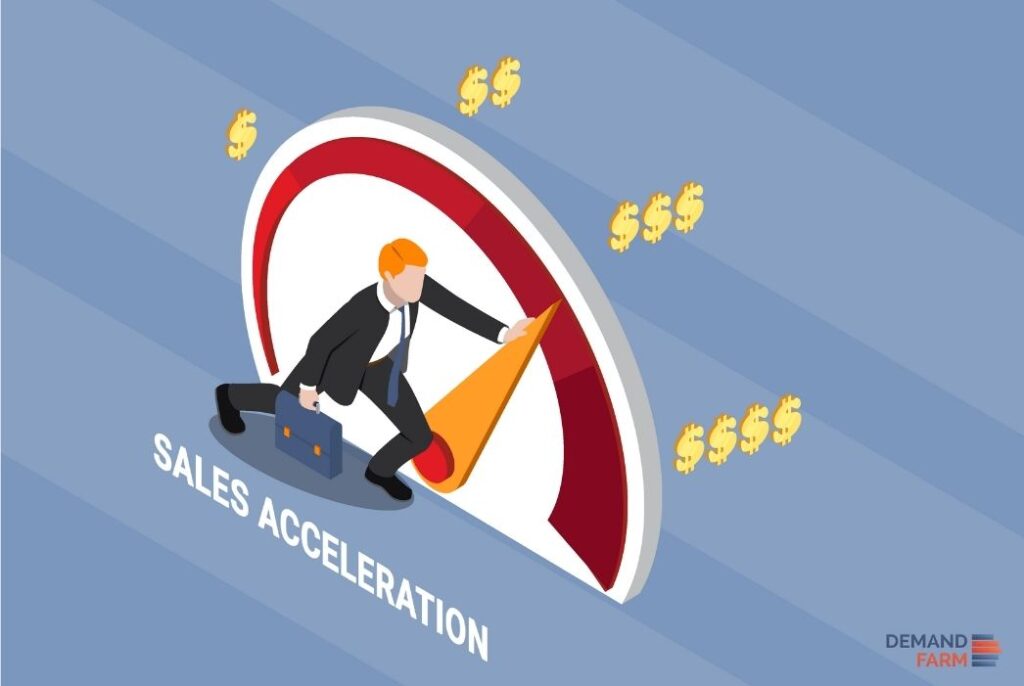Revenue operations vs Sales operations

To supercharge your business against your competition, there’s one aspect of prime importance that plays a crucial role – how good your operations are. Among all the operations in your business, two major ones that drive growth are Revenue Operations (RevOps) and Sales Operations (SalesOps). While they focus on different areas, they share a common goal – streamlining processes and operations so your core team can focus on what matters most: achieving their goals and tracking key metrics for success. Both RevOps and SalesOps are accountable for key metrics and KPIs, such as sales metrics, that drive predictable revenue and sales productivity and growth, including forecast accuracy. However, in order to truly optimize sales performance, it is important to have a well-developed sales operations strategy in place. This involves identifying key areas for improvement, implementing effective tools and processes, and continuously analyzing and adjusting based on key metrics and best practices. By building a strong sales operations strategy, businesses can ensure long-term success and growth in their sales operations. In this blog, we simplify the understanding of RevOps vs SalesOps. By the end of this blog you will be able to: Differentiate between the two and their functions Identify what is of prime importance for you at the moment – RevOps or SalesOps Understand when to hire a RevOps or a SalesOps team Revenue operations vs. Sales operations What is SalesOps? There’s one primary goal of creating a SalesOps team – to minimize the mundane administrative tasks for your sales reps so they can focus on one thing they have to – sell more. This team, made up of sales professionals and sales managers, focuses on optimizing in processes, technologies, and performance metrics to enhance sales efficiency and productivity. They work along with sales leadership and sales leaders, but away from the sales team that focuses on closing deals, allowing sales ops professionals to focus on their strengths and ultimately drive sales strategy. How SalesOps Works SalesOps work with one primary goal in mind – making the lives of sales reps better. They take over all mundane and administrative chores away from sales folks so they can work on what they’re best at – closing deals. They are responsible for creating a direction for the sales team so the sales process becomes more optimized. Here’s what they work on: Focus on territory mapping and offering tech stack support. Identify and implement KPIs for the sales team as a whole. Create training for new sales reps and prep them to be up and running along with the existing sales team. Identify areas of automation so repetitive tasks of sales reps are automated so they can sell faster. Define a standard sales process so the sales team has a vision and a direction to work on. What is Revenue Operations? RevOps, or Revenue Operations, aims to break down silos between departments so that all teams can collaborate effectively to remove barriers to profitability. It exists to drive revenue growth by enhancing the operational efficiency of the revenue team. In simpler terms, RevOps helps your teams work together more efficiently, providing a better, more profitable service to your clients. How RevOps Works RevOps functions a bit differently for each company, but it generally starts by: Setting Shared Goals: Aligning all customer-facing departments with common objectives. Unified Tech Stack: Integrating data from all departments into a single tech platform. Identifying Roadblocks: Pinpointing areas that hinder profitability and success. Optimizing Processes: Collaborating to refine processes and procedures to eliminate these obstacles. When to Hire Sales Operations Instead of Revenue Operations Choosing between SalesOps and RevOps is a key decision for any company looking to grow. Here are a few signs that indicate you might need to bring in a SalesOps team first: 1. Your CRM is in Disarray If your customer relationship management (CRM) system is chaotic and no one has the bandwidth to clean and manage the data, it’s time to consider SalesOps. They specialize in organizing sales databases and project scheduling. By keeping your CRM in order, SalesOps ensures that your sales team has easy access to the information they need to close deals and build relationships with customers, as well as efficiently onboard new hires and train teams on updated processes. 2. Administrative Tasks Overwhelm Your Team When your sales reps are overwhelmed with administrative tasks, it’s a clear sign that you need a Sales Operations Analyst. Without someone in charge of day-to-day operations and workflows, these responsibilities fall on your sales team, leading to inefficiencies. A Sales Operations Analyst can implement a time-tracking system to better understand how time is spent and make the team more efficient. As a result, your team can focus on their core responsibilities and drive sales strategy, ultimately leading to the growth of your sales organization and business. 3. Lack of Process Ownership If you notice that your processes aren’t as effective as they could be and improvements are not being made, it’s likely because there’s no one responsible for process management. SalesOps can step in to handle this crucial aspect, allowing your sales teams to focus on what they do best—selling. With SalesOps in charge, you can ensure that processes are continuously optimized through sales process optimization, ensuring smooth operations across all business units. 4. Budget Constraints for Startups For startups or companies with a tight budget, bringing on a SalesOps team can be a more cost-effective solution than RevOps. SalesOps requires less structural reorganization and can be integrated into your team with minimal disruption. This makes it an ideal choice for companies that need to optimize their sales processes without incurring significant expenses. 5. Inefficient Use of Sales Technology If your sales team is not making the most of the available sales technologies, SalesOps can help. They can evaluate your current tools, recommend new ones, and train your team to use them effectively, ensuring that your sales operations are as efficient as possible. 6. High Turnover Rate in Sales Team A high turnover
Why Leadership is Important in Sales

In the ever-evolving sales landscape, organizations grapple with post-pandemic shifts. Efficient sales leadership becomes essential to navigate these challenges and remain competitive. Sales leaders not only set strategies and inspire teams to achieve results but also play a vital role beyond mere management. While motivational speeches matter, true leadership demands flexibility, keen observation, and the agility to adjust leadership styles to market changes for efficient sales. Different leadership styles intertwine with sales. Effective leaders reshape a sales department, fostering an environment where teams eagerly strive for excellence. By collaborating with other department heads, sales leaders cultivate a sales culture that propels sales and achieves revenue targets. Leadership Styles in Sales According to a study by Harvard Business Publishing, quality sales managers will play a crucial role in driving revenue in the post-pandemic environment. Let’s look at different leadership styles in sales and their suitability in different sales contexts: 1. Autocratic Sales Leadership An autocratic sales leader comes closest to the conventional idea of a leader who makes most decisions unilaterally and without any participation of the team. Such leaders offer quick guidance to structured teams, especially in high-stress environments, allowing sales teams to focus without distractions. This takes the pressure off the sales team and helps them focus on selling without any unnecessary disruptions. 2. Transactional Sales Leadership Transactional sales leadership follows a result-oriented approach by promoting compliance and goal achievements. They thrive in mid-sized organizations with set sales processes, motivating teams with rewards, incentives, and commission strategies. Such leaders create and follow a system based on feedback, recognition, supervision and rewards. 3. Transformational Sales Leadership Transformational sales leaders are primarily mentors who focus on enabling sales reps with coaching and professional development. They focus on transforming and improving the sales culture of the organization. While they remain committed to the objectives and business values of the organization, they are also open to change. These leaders encourage teams to challenge the status quo, making them ideal for sectors needing continuous innovation. 4. Visionary Leadership Visionary leaders are committed to realizing the company’s vision and create the necessary strategy to guide the sales team towards this goal. Visionary leaders are highly organized and communicative and establish a sales culture that thrives on collaboration. They count on their EQ to win the trust of their team and inspire them to work towards achieving organizational goals. Visionary leaders have been instrumental in turning around companies after the pandemic and motivating sales teams to stay on course. Leading through Challenges The journey of a sales leader is often riddled with several challenges and they must possess the strength, skill and resilience to navigate challenges such as market shifts and competitive pressures. They should be able to handle changes in the industry, technology or overall economic conditions and pivot the sales team. Sales leaders can turn challenges into opportunities with these simple strategies and tips: Lead by example: Successful sales managers shield their team from the storm and absorb most of the stress posed by challenges. They push themselves more to set the right example for their team members. First to arrive at work and last to leave, they are there for individual sales reps to help them adapt and get past challenges. Leverage data efficiently: The ability to collect and analyze data efficiently is integral to sales success. They can’t afford to get buried under data and lose the plot by tracking too much or too little. Numbers can be accurate indicators of performance and leaders should be able to use them correctly to diagnose issues in the sales process. Show empathy: Any crisis or challenge can make or break a team and it’s up to the sales leader to hold fort by displaying empathy for team members. They must be appreciated for their efforts and encouraged by sales leaders to stay on track. It is also important to recognize and reward the contribution of sales reps who perform well under pressure. Communicate a clear strategy: Adversity turns sales leaders into wartime generals who communicate a clear vision to their team members. The only way to weave a tight team is by clearly communicating your expectations and conveying the conviction of getting past difficult times. Developing Sales Leaders Effective leadership is the result of many years grooming and nurturing leadership talent within a sales organization. The sales leadership role is right for someone who understands industry challenges, market dynamics and is adept at negotiating and closing deals. Successful sales leadership requires a certain skill set and the following essential attributes: Integrity: This is a non-negotiable quality of any great leader and goes a long way in inspiring their team and earning their respect and trust. Adaptability: Leaders need to stay abreast of latest technologies, industry trends and market dynamics to lead their team in the right direction. Decisiveness: Sales leaders are required to take many calls that decide the course of the company and its success. They should be able to process data, choose from different options and make quick but informed decisions. At the same time, they must enable their team members to make decisions and groom them as thought-partners. Humility: A good leader should be aware of his/her strengths and weaknesses and balance them with those of his team members. They should possess the humility to recognize their flaws and leverage the strengths of others who are stronger in these areas. Fortitude: Good leaders are made of Teflon and can endure tough conditions while retaining the zeal and drive to meet their team’s goals. Only a strong leader can inspire other team members to look for opportunity in adversity and stay focused. Success Starts at the Top Good leadership is critical for the success of not just the sales team but for the future development of the company. Sales fuels the growth of the organization and good leadership is the catalyst that can turn around a company’s fortunes. Success stems from the top and a good leader can be the
How TaskUs Achieved 30% Growth in Upsell Revenue & 20% Growth in Cross-sell Revenue

In this case study, we observe the key role of DemandFarm’s digital key account management software in increasing the upselling & cross-selling revenue of TaskUs. The case study covers Taskus’ journey of identifying the top key account management challenges to streamlining key account planning processes and finally registering revenue growth in its key accounts. Read the Entire Case Study by clicking here Watch More: Leaders of TaskUs sharing about their Digital Account Management journey with DemandFarm
Commanding the Digital Sales Battlefield: The Strategy You Need Now

Yes, sales, as we knew it, is history! Old-school selling approaches are going out the window. The Rolodex, the cold calls, the scripts practiced in front of the mirror – are all fast fading into the background. Welcome to the digital age of sales! Sounds intimidating? We’re here to ease some of that anxiety about going digital – needing to dominate the online landscape. Because diving head-first into the digital sales ocean isn’t just about chasing the latest technology; it’s about genuinely understanding your customer. With so much talk about technology and going digital, it’s easy to think that the revolution is just a technological one. But it’s equally about an evolution in mindset – a shift from transactional interactions to building meaningful relationships. As Julie Lentz, Head of Industry Retail Sales, Google puts it: “Selling is a science, and an art. Data is the IQ and knowing what to do with it, or understanding the humans that make decisions based on that data is EQ.” – (Snippets from episode #11 of The Shift podcast) The tools have changed, but the core remains the same. Remember the excitement of sealing your first deal or the satisfaction of a handshake signaling a closed sale? That essence is still here, just packaged differently. Today, sales strategy is like navigating a vibrant digital landscape. There are opportunities at every corner, beckoning you to explore. Digital-First Sales: What’s the Big Idea? As the digital age evolves, customers will continue to evolve from passive recipients to active participants. They seek more than sales pitches; they desire solutions, strategies, and partners to co-create value. It’s less about ‘selling software’ and more about demonstrating how it can transform operations and yield ROI. Customers want tailored strategies that address their unique challenges, market positioning and growth objectives. This is not a small minority. According to Salesforce, almost 3 out of 4 customers expect this. While efficiency might push you toward operationalizing sales, relying heavily on data and established patterns can overlook nuances of key accounts. Key accounts demand rich, durable exchanges, beyond surface-level pitches. Every interaction, request for proposal (RFP), feedback, and even subtle pauses during sales calls – all reveal a company’s needs. Here, technology steps in as an enabler. Acting as an accelerator, it helps sales personnel swiftly gain insights. This empowers them to be more strategic, build relationships and align stakeholders effectively. “Organizations have had to leverage technology to keep up with demand and manage operations. Technology brought value to processes, business operations, and intelligence. Clients who embraced technology quickly saw the benefits.” – Julie Lentz, Head of Industry Retail Sales, Google (Snippets from episode #11 of The Shift podcast) Sales in the digital era is about crafting partnerships. While technology’s benefits are vital, it’s equally important to focus on genuine insights and let human touch drive partnerships. The goal is to deliver solutions that resonate with customers and elevate the partnership. Data: Your North Star If there are questions or doubts about how to keep pace and remain competitive, the answer lies in data. Think of data like your GPS on this journey, guiding you through the maze of decision-making. A study by Salesforce revealed that salespeople who use CRM software are 40% more likely to close deals. Having relevant information and data at your fingertips puts you several steps ahead of those still playing the guessing game. Based on a LinkedIn report almost half of all businesses that focus on social selling achieve their sales targets. And, close to 80% of companies relying on social selling do much better than those who don’t prioritize it. It’s not merely about posting content; it’s strategic engagement, similar to choosing the right networking events in the pre-digital era. It’s not just about having the data. It’s about having the right data and leveraging it to tailor your pitches, understand market trends, and anticipate client needs before they even express them. “Data is a tool that should save time and help sellers develop insights faster. Data should enable sellers to shine as insightful individuals. It should free sellers to be more strategic in developing relationships and in stakeholder alignment.” – Julie Lentz, Head of Industry Retail Sales, Google (Snippets from episode #11 of The Shift podcast) Put Customers Front and Center Let’s consider an executive summit. Every detail – from the agenda to the keynote topics – is carefully chosen to resonate with the concerns, and appeal to the aspirations of the attendees. Your sales strategy should mirror this meticulous planning. You must recognize that your client isn’t just another name on a spreadsheet – they are the main event! Each proposal, solution and presentation must feel as if it was exclusively crafted for them. You must speak directly to their challenges and ambitions. There are statistics to back this up. Forbes reported that customer-centric companies enjoy a profitability rate 60% higher than their counterparts. That’s not just a small margin; that’s a game-changer! It has also been well-cited that a genuine focus on customer experience can skyrocket retention by a minimum of 25%. These aren’t mere numbers; they’re clear indicators of the immense power of a customer-first approach. Make use of your research, customer insights and industry knowledge to make every client feel special. Every single interaction and touch point should reflect your intention at creating partnerships aimed at mutual growth. Ensuring your clients are in the lead is not just a smart strategy – it’s the foundation for lasting partnerships and sustainable business success. Tech It Up! In the world of B2B sales, where securing deals could mean navigating through layers of decision-makers and procurement systems, technology isn’t just an option – it’s your competitive edge. The days when sales decks were manually updated and leads tracked in bulky files are long gone. Today, businesses are employing advanced Sales Engagement Platforms to automate and optimize every step. Predictive Analytics have become the go-to for market trends forecasts and client needs prediction. Digital evolution isn’t
Automate to Accelerate: Streamlining Sales Processes for Greater Efficiency and Productivity

Automate to Accelerate: Streamlining Sales Processes for Greater Efficiency and Productivity Automation of standard and routine tasks is one of the biggest trends that is shaping the modern business landscape. Top companies and organizations are keenly embracing automation to drive cost efficiency and improved sales. Automation in the sales realm is proving to be particularly useful as it helps streamline several processes resulting in higher productivity and efficiency. Several new-age tools are being adopted to eliminate or reduce the time spent on tedious or administrative tasks and free up bandwidth for sales reps to focus on revenue-generating tasks. A cross-functional research conducted by the McKinsey Global Institute (MGI) reports that technology can automate almost a third of sales and sales operations tasks. For instance, messages shared by salespeople at different junctures of the customer journey can be automated. This simple automated task gives them more time to nurture leads to close more deals and consolidate existing customer relationships. Understanding Sales Automation To fully understand the application and benefits of sales automation, let us first understand what it entails. Sales automation is the process of leveraging software and digital tools to automate a wide range of sales processes from email marketing, to lead generation and sales forecasting. The most widely used tools for sales automation leverage artificial intelligence (AI) and include chatbots, virtual assistants, email, and appointment automation. For example, a gym sales CRM can help streamline tasks like membership management, client follow-ups, and appointment scheduling, improving overall operational efficiency. These cutting-edge tools are invaluable resources for sales reps and help them finalize more deals while establishing stronger relationships with customers. Sales automation tools can also be merged with customer relationship management (CRM) systems to provide smarter insights into the requirements of your buyers. By understanding your audience, their needs, habits, and pain points, you can customize and fine-tune your sales strategy and customize your campaigns to funnel leads through the customer’s journey. Lead Generation and Management Leads are generated in large volumes at the beginning of the sales process. Sifting through this ocean of data can be tiring and time-consuming. It’s also challenging for your sales reps to gauge a lead’s actual interest in your product or service. Thanks to sales automation tools, you can now prioritize leads, channel your team’s energy, and focus on the most valuable ones. By leveraging artificial intelligence, sales automation tools can simplify several tasks such as lead generation and lead scoring, and achieve maximum conversions and higher efficiency. During the prospecting stage, sales automation tools provide information about leads to sales reps and help them create a great first impression. Your sales team spends a lot of time and energy in qualifying leads and remains uncertain about conversion. They can now rely on automation of the lead prioritization process to qualify leads faster. Sales automation tools can ensure that prospects are right for your business before you start contacting them. This process is a boon, especially for organizations that face the challenge of longer sales cycles and low conversion rates. Sales reps depend on lead scoring to know the status of the lead in the sales process. By leveraging lead scoring they can decide if the lead is sales ready, a warm lead, or a cold lead. A sales tracking software can automate this process and help you identify people who are most likely to buy from your business. Instead of servicing every customer, your team can concentrate on interacting with warm leads and ensuring their conversion. They can also tap into automated lead enrichment tools to mine customer information from different data sources. This arms your sales reps with a comprehensive profile of prospects to nurture their relationship with them. Streamlining Sales Funnel and Pipeline Management It’s the aim of every business to maximize leads in their sales pipeline, as more leads result in more conversions and higher profits. However, managing leads and converting them requires more sophisticated tools than spreadsheets and email. With the help of sales automation tools, a large volume of leads can be managed in the sales funnel. AI-powered sales automation tools mine customer data and contact details and streamline regular communication apart from making product recommendations to customers. You can also utilize these tools to standardize and refine the sales workflow over time. Sales automation provides a holistic picture of your sales pipeline and aids in the identification of promising leads and opportunities. They also give you an overview of where the prospects are placed in the buying cycle and help you strategize successful conversions. Sales Reporting and Analytics Automation tools are also favored for their analytics and reporting capabilities. In order to stay on top of your KPIs and sales metrics you need access to in-depth analytics. These tools are a great asset as they are capable of automatically generating reports for stakeholders and managers. Sales leaders are increasingly counting on sales automation to spot opportunities and make data-driven business decisions. Automation is more relevant than ever as it helps in generating consistent data and processes for your entire team. With the help of automation, you can avoid discrepancies and duplications that might hamper your sales processes. By reducing the scope for human error, you can guarantee the accuracy of your data and findings. Integrating CRM and Sales Automation In these times dominated by digital innovations, optimizing the customer experience and staying ahead of the competition requires us to actively integrate our systems and create scalable synergies. By adopting Salesforce integration, we can bring together CRM systems and sales automation and streamline these processes. AI tools used in sales automation play an important role in understanding customers creating a deeper understanding of prospects. Data from various sources such as CRM systems, website interactions, and social media is analyzed to create customer profiles that are a big asset for sales reps. This is just one example of salesforce integration, and sales automation features are included in many CRM systems. Integrating these two integral platforms can go a long
B2B Revenue and the (Ir)relevance of the Funnel

Originally published in Forbes Business Development Council Traditionally, one of the core concepts of sales and marketing is the sales funnel through which companies are supposed to move prospects from awareness through consideration to engagement, and finally to purchase. Here are three examples where this breaks How does funnel make sense if 67% of the sales cycle is completed on digital channels before contacting the company? Opportunities from existing customers in the case of cross-sell & upsell start at the bottom of the funnel. In case of ‘booked’ revenue, typical opportunities don’t get created most of the time, so funnel is not even in the picture here. Is the B2B Sales Funnel relevant anymore? One of the main issues with the sales funnel, especially in the B2B industry, is that the customer journey is no longer linear. Prospects no longer enter at just the top of the funnel. Customers come in at any stage and often jump stages or move back & forth between them. Since customer acquisition has changed within the B2B sphere, the sales funnel is a bit outdated. What happens in a conventional sales funnel? Marketing generates a bunch of leads and passes the qualified ones to sales who then attempt to win the deals. Several B2B companies offer not only many solutions, but solutions that involve long-term engagements with their customers. For such organizations, winning the deal is only the beginning. In certain cases, Key Accounts are further identified which are given additional attention. In order to bypass the inconsistencies that the ‘sales funnel’ approach brings, a shift in perspective might be necessary. What if B2B sales and marketing are seen from the perspective of distinct revenue streams? The 4 streams of revenue for a B2B Company There are four primary sources of revenue for any B2B company. New revenue – Opportunities from new customers Renewal revenue – Renewal opportunities from existing customers Booked revenue – Revenue contribution from existing contracts for a multi-year engagement. This is different from renewal revenue in the sense that product/services have to be delivered to realize the revenue. Opportunities rarely get created in the CRM for this stream of revenue. Cross-sell/ Upsell revenue – Cross-sell and Upsell opportunities from existing customers. The approach to each of these revenue streams is different. Depending on which of the four sources contribute to the most revenue in your organization, the approach changes. The major revenue streams will determine the sales and marketing strategy, and corresponding sales and marketing tech stacks. Which revenue stream is dominant in your industry? Industries/ Revenue Streams New Revenue Renewal Revenue Booked Revenue Cross/Up Sell Revenue Mid to Large Business Services 5-10% 5-10% 60-70% 10-20% Mid to Large B2B SaaS companies 15-25% 65-70% 5-10% 15-25% Mid to Large Manufacturing/Industrial 20-30% 5-10% 60-70% 10-20% Small companies / Early stage solutions 30-50% 30-50% 10-20% 10-20% Depending on the industry and size of an organization, its dominant revenue stream varies. For Mid to Large Business Services such as IT, Professional, Staffing, Marketing, Outsourcing, the dominant source of revenue is ‘Booked Revenue’ For Mid to Large B2B SaaS companies, ‘Renewal Revenue’ should be prioritized For Mid to Large Manufacturing/Industrial, ‘Booked Revenue’ is the most dominant source For Small companies – Early stage, commoditized or undifferentiated products/solutions- ‘New Revenue’ and ‘Booked Revenue’ dominate revenue streams. A point to note in all these different types of industries, cross-selling and upselling are often the second leading source of revenue. This stream is also the biggest contributor for the account growth. Revenue streams should shape your sales and marketing approaches. Depending on which revenue stream is most dominant in the industry, the sales and marketing approaches should change. Each type of revenue stream requires different teams and different aspects of sales and marketing to be prioritized. This does not mean that there is no overlap between the sources of revenue or the sales and marketing approaches they require. However, it does imply that optimizing and streamlining them can help your ROI. Winning the CFOs approval: How to Present RoI of a Key Account Management Software What should companies seek in a revenue platform? An ideal revenue platform enables a business to efficiently and effectively manage its revenue streams. Such a platform should have several key features that make it the go-to solution for businesses looking to optimize their revenue streams. 1. New Revenue Platform If you are looking to increase revenue from ‘New Revenue’ sources, it’s necessary to have a specialized tool that can help convert more deals by finding more leads with the aid of prospecting tools. Sales Tools for New Revenue A perfect sales tool for optimizing new revenue streams should ideally have Sales automation for repetitive tasks Visual sales pipeline management to track deals, manage sales stages, and monitor progress. Customer relationship management with a centralized database Sales forecasting with insights for revenue forecasting and trend analysis. Gong is a great example of this – it uses AI to analyze sales conversations and give you data-driven advice on how to close deals faster. Such a platform captures and analyzes data from customer interactions to help sales teams make data-driven decisions. In case of large deal sizes, a platform like DemandFarm’s Opportunity Planner makes large deal management easier. Such a platform provides a systematic and collaborative approach to planning and closing large, complex enterprise deals. This is done by integrating proven sales methodologies with strong stakeholder management to enable faster deal closures. Marketing Tools for New Revenue A perfect marketing tool for optimizing new revenue streams should have features including: Lead generation capabilities through various channels Marketing automation for repetitive tasks Customer segmentation to create targeted campaigns Analytics and reporting to track campaign performance, analyze trends, and identify opportunities for optimization. A tool such as HubSpot is an all-in-one marketing, sales, and customer service platform that helps businesses to grow and manage their customer relationships. Such a marketing tool enables businesses to create and track
Analysts’ Predictions of AI for Sales, Account Management and Sales Enablement in 2023

Artificial intelligence (AI) is a rapidly evolving technology that is transforming various industries. Sales, account management, and sales enablement are no exception. According to a recent report, the global AI market in sales is projected to reach USD 12.4 billion by 2025, up from USD 1.3 billion in 2019. This rapid growth in the use of AI in sales and account management underscores the technology’s importance to businesses worldwide. Imagine you’re a sales manager for a large retail company with hundreds of sales representatives operating in different regions. Your job is to ensure that the sales team hits their targets every quarter. You must also provide regular updates on the team’s performance to the executive team. Imagine how challenging it is to keep track of each sales rep’s performance and to provide actionable insights to help them improve. This is where AI comes in. With AI, you can automate various processes such as lead generation, customer segmentation, and sales forecasting. It also becomes easier for you to guide and coach your team to improve their performance. If you want to know how AI will shape the world of sales in 2023, this article will help. Discover the latest predictions made by leading industry analysts on the role and impact of AI in sales, account management and sales enablement. Read More: Harness the Power of Big Data to Surge in Key Account Planning & Account Growth Overview of the Current State of AI in Sales, Account Management, and Sales Enablement AI has been transforming the sales and account management landscape for several years now. With the ability to process vast amounts of data, analyse patterns, and make predictions, AI helps in improving business performance and aids sales growth. Recent data shows that when AI is used to aid sales processes, leads increase by 50%, call times and overall costs are reduced by about 60%. A brief history of AI in Sales, Account Management, and Sales Enablement AI has been a buzzword in the technology industry for many years, but its practical application in sales and account management has gained momentum only recently. Sales and account management professionals have been using AI to automate tasks and optimize performance. For example, sales teams use AI to generate leads, personalize sales pitches and forecast sales. Account managers are using AI to segment customers, monitor contract renewals, and upsell or cross-sell. Sales enablement tools use AI to deliver personalized content, track engagement and improve sales reps’ productivity. Current State of AI Implementation in Sales and Account Management The use of AI in sales and account management is growing at a rapid pace. AI can automate repetitive tasks like data entry, lead prioritization, and follow-up emails. It can also provide insights into customer behavior predicting the likelihood of churn, the probability of purchase, and the optimal time to connect with customers. AI-powered chatbots are becoming more prevalent in sales and account management, providing instant support to customers and prospects. Close to 70% of users enjoy the speed at which chatbots answer. Overview of Sales Enablement Technologies that Use AI Sales enablement tools have been integrating AI to improve their functionality and deliver better results. AI-powered sales enablement technologies can help sales teams with lead scoring, sales forecasting and personalization. They can also assist with content creation, management and distribution. Over 40% of marketers agree that using AI for email marketing generates higher market revenue. AI can also provide insights into content performance, enabling teams to adjust their sales strategy and approach based on what’s actually working. AI can also help sales reps prioritize their leads and opportunities, ensuring focus on the most promising leads. Ebook: AI-Assisted Account Planning – Conversations of the Future Part 1 Revolutionizing Sales and Account Management: The Emerging AI Trends As AI continues to make significant inroads in sales, account management and sales enablement, new trends and applications will continue to emerge. Some of the most promising and exciting developments in AI for these fields include chatbots and virtual assistants, predictive analysis, machine learning (ML) to improve customer experience, and AI-powered sales performance monitoring and improvement. AI-powered chatbots and virtual assistants: In recent years chatbots and virtual assistants have become increasingly popular in sales and account management. Through extensive use of natural language processing (NLP) and machine learning (ML), these tools can automate routine interactions, answer commonly asked questions and even make product recommendations. According to Grand View Research, the global chatbot market is expected to grow at a compound annual growth rate (CAGR) of 25.7% from 2022 to 2030 and reach USD 3.99 billion by 2030. Predictive analytics for sales and account management: Predictive analytics can help sales and account management teams identify potential customers and personalize their outreach. Through the analysis of data including purchase history, website behavior, and social media activity, predictive analytics tools can identify which prospects are most likely to convert. They are also able to determine which messages will resonate with them. With over 50% of companies worldwide leveraging advanced and predictive analytics, the benefits are obviously widespread. Machine learning for customer experience improvement: ML is used by sales and account management teams to better understand their customers and improve customer experience. By analyzing data from emails, chat logs, and social media, ML algorithms can identify patterns and threads in customer behavior. With these reports sales teams can receive personalized recommendations and tailor their approach to each customer. A study by Salesforce shows that almost 90% of customers believe that the experience offered by a company is equally significant to its products or services. Automation in sales and account management: In sales and account management, automation helps with streamlining workflows, helping teams focus on high-value tasks. By automating tedious and time-consuming tasks like data entry, lead prioritization and follow-up emails, sales teams can save time. Thus efficiency is also improved. This helps to free up time for more productive activities like lead generation and nurturing. Research by McKinsey Global Institute has shown that over one-third of
Gartner 2022 CSO and Sales Leaders Conference

Event Overview As the events of the past couple of years continue to transform the business landscape, the top priority for CSOs right now is to adapt, manage disruptions, and emerge as winners in the new normal. The Gartner CSO & Sales Leader Conference 2022 was all about bringing the right insights and expert guidance to help them achieve those objectives. Catch a glimpse of the future of digital account management and delve into the real-world digitization challenges being faced by enterprises today. Check out our exclusive fireside chat to discover the critical role of Key Account Management from the customer viewpoint with Co-founder and COO of DemandFarm, Mr. Milind Katti and leaders from Zebra Technologies and TaskUs. Take a deep dive into… Data and its impact on sales strategies The potential of strategic accounts with digital account planning How digital evolution is shaping the future of account management Explore unique perspectives on key account management Watch our fireside chat hosted by Anand Makwana Senior Manager – Analytics and Strategy, Zebra Technologies Isaac Puno VP Sales Enablement, Chief of Staff & CCO, TaskUs Milind Katti COO & Co-Founder, DemandFarm The Best Tools for Your Team At DemandFarm, we’re all about helping businesses stay ahead of evolving customer expectations with adaptive strategies. Learn how you can leverage our expertise and optimized account management solutions to drive key account growth and boost ROI. Streamline relationship intelligence with visualized org charts Learn More Redefine key account management with digital account planning Learn More
Driving Sales Excellence in 2025: What, Why, and How?

Our story begins in 2003, a time of great distress in British Cycling. The national cycling team of Great Britain was the epitome of mediocrity at the time, having won just one medal in a century of existence. Fast-forward to 2008 and the squad took home 7 out of the 10 available medals in the Beijing Olympics – a remarkable feat that they would repeat in the 2012 London Olympics. In fact, by 2015, the squad had even won three Tour de France – the holy grail of competitive cycling. Make no mistake. This is much more than your average rags to riches story. But a natural question begs – how did the worst cycling team in the world suddenly turn into world champions? Our answer lies in the strategy of “the aggregation of marginal gains”. It was Introduced by Dave Brailsford in 2003 when he was appointed the new performance director of British Cycling. The idea was simple yet hauntingly effective – to think small and not big. This involved breaking the entire process of competing into its constituent elements and then improving each of them by 1%. In practice, this meant painting the floor of the team truck white to spot impurities that undermine bike maintenance, hiring a surgeon to educate team members on ideal hand-washing techniques to avoid illnesses, making athletes sleep in the same postures every night, and other such countless initiatives. Why does this work? How can such small improvements accumulate into such head-turning results? And most importantly, what can we learn here that can be implemented in sales and account management? Sales Excellence: Getting Ready for 2024 The What and Why of Sales Excellence As reported by Salesforce, organizations spend anywhere between 5 – 15% of their entire revenue on sales. Revenue. Not profits. This is as significant as an investment can get in a single organizational department. Naturally, it makes sense to have a well-defined framework that milks the maximum possible ROI from the equation. And this is where Sales Excellence comes in. In Key Account Management, Sales Excellence is an amalgamation and progression of all possible sales functions. Drawing parallels from the management philosophy of Dave Brailsford, this would mean constant improvement in all key initiatives that go into sales – sales training, sales culture, sales tools, sales technology, and more. From a 360-degree point of view, Sales Excellence model translates to stepping into the world of British Cycling. It cares about everything – the number of deals that are closed, deals closure times, deals won rate, the support level extended to salespeople, and much more. What Ideal Sales Excellence Looks Like For Sales Excellence and Sales acceleration to function at its ideal capacity, leaders and the organization at large need to live and breathe the practice. For a concept that involves attention to detail at unprecedented capacity, anything less than 100% buy-in would be a shame. What does such dedication look like in practice? At the foundational level, Sales Excellence strategy begins with staunch onboarding, training, and up-skilling support for salespeople in a manner that grows into the shoes of a pan-organization culture. Sales Excellence means that salespeople are not only attuned to the best practices of sales but also work closely with other departments (such as marketing) to better understand the personalized needs of every buyer. Key ingredients to formulate an ideal Sales Excellence framework includes: Sales Strategy: Scoping, understanding, and implementing ideal sales targets and budgets by taking into account both current and potential customer segments. Market Penetration and Development: Defining the best mix of digital channels that promotes market penetration at maximum capacity. Sales Processes: Defining the end-to-end sales structure and making crucial decisions related to key account management, customer classification, customer acquisition, and more. Pricing Strategy: Increasing profitability with the right pricing strategy in place. This includes closing the right number of deals, defining key accounts, order management, and more. Impact of Sales Excellence on Deal Closures In a traditional capacity, sales are driven by taking into account how effective the entire organization or sales department is in executing their roles and responsibilities. But such monitoring is often undertaken at a bird’s eye level with KPIs catering to teams or entire sales functions. Sales Excellence goes way beyond this and brings a fundamental shift in this practice. Sales Excellence questions not just the leaders or the sales functions but every individual salesperson. This means monitoring metrics such as the deal closure time, deal win rate, the training and proficiency levels of salespeople with the tools, organizational support, and the like. What does this mean? When the spotlight is on every individual salesperson, improved deal closure is nothing more than a natural byproduct of the practice. Revisiting the story of the British Cycling team, focusing on every detail in the small picture ultimately has a significant cumulative impact on the big picture. How to Measure Sales Excellence Now that you know what Sales Excellence is all about, the next step is figuring how to measure it. The age of Sales Enablement and Sales Transformation has paved the way for many key metrics and frameworks that need to be put to ideal use to measure success in Sales Excellence. Here is a round-up of the key metrics that you should be focusing on: Time to Full-Ramp: How much time does a salesperson spend to put up his/her shop? The quicker they are set up and running (in both individual and organizational capacity), the better the results. Collateral Engagement: So you have provided every salesperson with the ideal content and sales collateral. But are they putting them to good use to move prospects through their buying journey? Communication Analytics: Are salespeople eager to up-skill and keep up to date with organizational and product updates? Monitoring communications (at a high level) can be indicative of their eagerness to be prepared. Sales Performance: This is a direct measure of the effectiveness of all sales efforts and includes monitoring KPIs such as
Sales Acceleration – The Complete Guide

Sales acceleration could be compared to a Formula 1 pit stop. Formula 1 pit stops are the most nerve-wracking events of a Grand Prix race. The cars decelerate to make it slowly into the pit from a top speed of 240 mph. The pit crew pounce into the car – fuel-ups, changes tires and completes the check-up in a matter of seconds. The world record for the fastest pit stop in 1.82 seconds. Let that sink in. The perfect pit stop happens because of the synchronized activities of a hundred team members working on the minutest of details. The Mercedes team has over 980 team members, with each of them working round the clock to get every possible detail of the car right. Sales acceleration does the same to a lead as the lead begins its journey towards becoming a customer. An inbound lead fills a demo form on the website. The user analytics software tracks source (Organic search, referral, or social media) and the complete journey of the lead on the website – pages visited, time spent on-page, and what prompted them to fill the form. Based on the email id of the lead, the lead enrichment tool updates the company information of the lead including details such as Job Title. The lead insights tool quickly gathers all market-related information about the company such as new CEO, new product launch, fund-raising, and the new roles the company is hiring for. The sales rep is now armed with enough data points to have an intelligent conversation with the lead. Sales acceleration isn’t done yet. There is more including automated calling, fallback emails, automatically scheduling meetings, and more. Let us accelerate and go deeper. What is Sales Acceleration? Traditional sales methods of prospecting are over, almost. Cold calls are out. Inbound sales is in. Lists are out. Intent driven inbound leads are in. Transactional sales is out. Contextual consultative sales is in. Sales acceleration is the perfect answer to respond to the challenging demands of new age buyers. Sales Acceleration may seem like a self-explanatory concept, but it is far from it. At the surface level, it is about improving the speed and efficiency of the sales process. The idea is to identify key areas of improvement in the sales process and scale them in a way that adds tremendous value. This may include: Reducing process inefficiencies and refining the results Leveraging key trending technologies that accelerate sales Systematic and scalabe training to the sales team Aligning marketing and sales with SLAs that are in line with changing market conditions Continuous analytics to drive a metrics driven culture Analysts and industry thought-leaders have heaped praise on sales acceleration. Analyst firms such as Gartner and Aberdeen continue to raise projections for the sales acceleration market. User review websites like Capterra, G2Crowd, and Software Advice now even have a separate category featuring sales acceleration software. Sales leaders, managers, and even users are talking about the need for sales acceleration, and with good reason. Why Sales Acceleration matters? There is no denying that the sales industry has undergone fundamental evolution. Your average sales rep today is no longer overbearing to the point of repulsion. Instead, they are highly trained, professional, and empathetic personalities who constantly check on their customers and guide them towards gentle, value-oriented sale closures. How is this achieved? By using the right amount of research, analytics, and a number of software tools including account planning software. What was once a soft-skill, now also includes a technically sound and process-driven culture. With the right team culture, sales acceleration fits right into this equation. It makes use of processes and data to achieve sales success, rather than relying on ad-hoc decisions and hunches. That isn’t to say that soft-skill of sales doesn’t matter in the equation. The sales equation also has another factor at play – the buyer. The new B2B Buyer needs no sale Gartner in one of their recent sales insights summarized the B2B buying situation well. Sales teams have very little opportunity to influence customer buying decisions. All the information related to the purchase is available online via digital channels. Gartner research says, “When B2B buyers are considering a purchase‚ they spend only 17% of that time meeting with potential suppliers. When buyers are comparing multiple suppliers‚ the amount of time spent with anyone sales rep maybe only 5% or 6%.” A study by CIO Insights in the recent past made similar claims. It claimed that 70% of buyers have already done their requirement analysis before speaking to a sales representative. Close to 50% have already decided the solution before engaging with sales. No wonder sales is becoming a channel rather than ‘The Channel.’ This growing B2B buyer behavior aligns really well with a sales acceleration approach to sales. Something, which was demonstrated with success by Mark Roberge at HubSpot. The Sales Acceleration Formula – Mark Roberge Mark Roberge is the best selling author of the book ‘The Sales Acceleration Formula.’ In the book, Mark (Chief Revenue Officer of HubSpot) describes how he devised a sales acceleration formula for scalable and predictable revenue growth at HubSpot. Using this, he was able to scale revenue to $100 million in 7 years. According to him, the Sales Acceleration formula or process has 5 key pillars. Sales Hiring Formula Defining the ideal characteristics of a salesperson for your organization and devising a framework to test these skills. Finding top-performing salespeople by incentivizing internal recruiters on success rates. Determining the first ideal hire in the sales team, someone that perfectly aligns with the characteristics, long-term vision, culture, and maturity. Sales Training Formula Creating a systemic sales training program that is focused on the buyer journey, sales process, and sales qualification matrix. Taking into account individual traits and skills of salespeople in a way that is predictable and scalable. Constantly iterating the sales training program and ensuring that it aligns with the needs of the team instead of merely the organization. Sales Management Formula Sales Training: Focusing on a